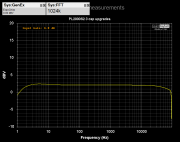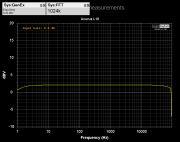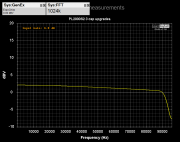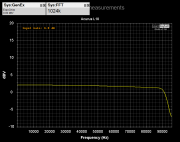I am glad to hear that I don’t have to write any new laws of physicsWell thanks, but I need challenged as I don't have the background for this, I'm more of a mechanic.
Have very nice square waves at 1 kHz.
Here's 20 kHz. Looks good compared to what I've seen on other sites.
Going to be a couple hours or so until I can generate a FR, need to do a few things for the wife, then I can get back to it.
Thanks Joe!
You are using an out of date browser. It may not display this or other websites correctly.
You should upgrade or use an alternative browser.
You should upgrade or use an alternative browser.
PL2000 preamp square wave ringing.
- Thread starter George S.
- Start date
J!m
Veteran and General Yakker
Just more laws for me to break…
Joe, you did it. Results look very good.
The PL has appx 1/2 dB rise over the Acurus at 4 Hz.
I ran the frequency response out to the Nyquist Limit, appx 90 kHz.
The PL is down appx 1/2 dB at 45 kHz, the Acurus is down appx 1/2 dB at 75 kHz.
Thank you! This is going to help a lot of people who want to run a PL preamp with their WOPLs.
C18, C20, 15pF or 7pF silver mica (I used 7pF, got slightly flatter high frequency response)
C42, C43, 100uF electrolytic
C21, C22, 2.2uF film
The PL has appx 1/2 dB rise over the Acurus at 4 Hz.
I ran the frequency response out to the Nyquist Limit, appx 90 kHz.
The PL is down appx 1/2 dB at 45 kHz, the Acurus is down appx 1/2 dB at 75 kHz.
Thank you! This is going to help a lot of people who want to run a PL preamp with their WOPLs.
C18, C20, 15pF or 7pF silver mica (I used 7pF, got slightly flatter high frequency response)
C42, C43, 100uF electrolytic
C21, C22, 2.2uF film
Attachments
Last edited:
- Joined
- Jan 14, 2011
- Messages
- 75,823
- Location
- Gillette, Wyo.
- Tagline
- Halfbiass...Electron Herder and Backass Woof
that doesn't matter George, PL just increased the gain in the S2 compared to the S1. About 2:1
And it needed some...
mlucitt
Veteran and General Yakker
And R72 is also 7.5K in the Left channel for the Series II (and as modified in my Series I).Yup, I just measured it on the board. The S2 R71 is 7.5k.
GeorgeP
Journeyman
- Joined
- Mar 22, 2023
- Messages
- 131
Those op-amps have phase shift...and so some can be unstable driving the capacitive DC blocking circuit.
Easy fix...put a 50 to 100 ohm resistor in series with the back-to-back DC blocking caps on both channels to isolate the capacitive loading.
I have a new design on this website for a cleaner new design, if your interested in building one. I have a 2000 that I upgraded with new 40 MHz op-amps..,. much cleaner and distortion less. The switches are a bit noisy, so I derided to do a ground up re-design to replace this preamp. Clean square waves and triangle waves with very very sharp peaks also.
Easy fix...put a 50 to 100 ohm resistor in series with the back-to-back DC blocking caps on both channels to isolate the capacitive loading.
I have a new design on this website for a cleaner new design, if your interested in building one. I have a 2000 that I upgraded with new 40 MHz op-amps..,. much cleaner and distortion less. The switches are a bit noisy, so I derided to do a ground up re-design to replace this preamp. Clean square waves and triangle waves with very very sharp peaks also.
Thanks GeorgeP
I've been following your thread on the new preamp when you posted, haven't seen anything lately and didn't know if your still at it.
I want to take the original board as far as possible.
The PL2000 is a learning tool for me as I have no background in electronics.
Does your board drop into a original chassis? You should post some photos.
I and I'm sure others are interested in what your doing.
You'd probably sell some boards.
I've been following your thread on the new preamp when you posted, haven't seen anything lately and didn't know if your still at it.
I want to take the original board as far as possible.
The PL2000 is a learning tool for me as I have no background in electronics.
Does your board drop into a original chassis? You should post some photos.
I and I'm sure others are interested in what your doing.
You'd probably sell some boards.
mlucitt
Veteran and General Yakker
Which OPAMPs are you referring to? The OPAMPs we use are the Texas Instruments, Burr-Brown Division, OPA134 or the dual channel OPA2134. These are 8MHz Gain Bandwidth, 20V/us Slew Rate, 0.00008% @ 1kHz THD+Noise, 100db Common Mode Rejection Ratio, 120db Open Loop Voltage Gain, FET Input unity-gain stable devices that provide excellent dynamic behavior over a wide range of load conditions including high load capacitance. They can be driven from +/-2.5V to +/-18V Rails and will swing the output to within 1V of the Rail Voltage for maximum headroom in audio circuits.Those op-amps have phase shift...and so some can be unstable driving the capacitive DC blocking circuit.
From the Texas Instruments Datasheet:
"The OPA134 series of operational amplifiers are free from output phase-reversal problems. Many audio
operational amplifiers, such as the OP176, exhibit phase-reversal of the output when the input common-mode
voltage range is exceeded. This can occur in voltage-follower circuits, causing serious problems in control loop
applications. The OPA134 series operational amplifiers are free from this undesirable behavior even with inputs
of 10-V beyond the input common-mode range."
And it's worth noting that phase shift is meaningless in itself. A constant delay (which delays all frequencies equally) results in a consistent phase shift, in which all frequencies arrive at the same time. And this will be the case as long as the phase shift is linear with frequency.
Viewing the "Open Loop" Phase vs. Frequency chart on the datasheet, the Phase Shift is a linear -90.0 degrees from 100Hz to 200kHz. Of course, our OPAMPs are used in a closed loop (with feedback), so the chart is a worst case scenario.
See the Datasheet, page 8:
https://www.ti.com/lit/ds/symlink/o...l=https%3A%2F%2Fwww.ti.com%2Fproduct%2FOPA134
If this sounds like an advertisement, it is. I believe this is the best AUDIO OPAMP available today.
GeorgeP
Journeyman
- Joined
- Mar 22, 2023
- Messages
- 131
I used this one. I'm preparing to post a complete update tonight. This chip is beyond belief great. None better at this time, and hard to believe that anything else new would ever make an improvement.
Attachments
GeorgeP
Journeyman
- Joined
- Mar 22, 2023
- Messages
- 131
Its a totally new layout. I'll be posting the up date tonight.Thanks GeorgeP
I've been following your thread on the new preamp when you posted, haven't seen anything lately and didn't know if your still at it.
I want to take the original board as far as possible.
The PL2000 is a learning tool for me as I have no background in electronics.
Does your board drop into a original chassis? You should post some photos.
I and I'm sure others are interested in what your doing.
You'd probably sell some boards.
mlucitt
Veteran and General Yakker
The OPA1611 is a Bipolar input device and the cost (from Ti) is $4.10 each. But the downside for me is the SOIC surface-mount package.I used this one. I'm preparing to post a complete update tonight. This chip is beyond belief great. None better at this time, and hard to believe that anything else new would ever make an improvement.
The OPA134 is a FET input device and the cost (from Ti) is $2.47 each. These are PDIP packages and make replacement (and OPAMP rolling) easier.
Maybe Joe can chime in with advice, technical difference, advantages, and other opinions.
GeorgeP
Journeyman
- Joined
- Mar 22, 2023
- Messages
- 131
I understand the surface mount chip apprehensions, but this is easier to do than I thought. Easy "touch-and-go", and its down, holding it in place carefully on the first pin with tweezers, then the rest is easy. I also have seen SMT to PDIP with pins as interface boards for sale. I used them on my 2000, then I decided to redesign a new preamp with newer chips and love it. The Bipolar technology is now better, since the bias points are better controlled, better than the VGS variations... so I guess that's why the newer chips are made this way, and achieve very low input currents, very high input impedances, and NO distortion at all.
Try the interface boards, they are expensive for a chip already mounted on one... but, its a one time test anyway, or you can leave it that way. My 2000 has them. Pin for pin compatible. I'm getting ready to post the sale of the boards on EBAY. I'm cleaning up the parts lists, so I'll have them ready soon.
Try the interface boards, they are expensive for a chip already mounted on one... but, its a one time test anyway, or you can leave it that way. My 2000 has them. Pin for pin compatible. I'm getting ready to post the sale of the boards on EBAY. I'm cleaning up the parts lists, so I'll have them ready soon.
mlucitt
Veteran and General Yakker
George, have you ever considered installing a headphone jack in your PL2000? I think these preamplifiers could use a headphone jack...
if done correctly.
if done correctly.
Mark L. honestly, I'm rather glad they don't have a headphone jack, and wish they didn't have the added complexity of the rear channel output jacks and ambience.
I do have the switches and Dale resistors to build Dale ambience attenuators, just need to be bored enough to get to it.
Something I've strove for is this idea that member George from Oz (the retired sound man) brought up years ago. "Can you make the system sound great at low volume levels?".
I've achieved that with active DSP crossover and painstakingly accurate measurements and driver impulse alignment.
Should be easy enough to add a headphone jack, but, personally, I have no need for one or want one.
I just lower the volume more if a conversation is going on in a nearby room.
I know this is weird, but the music is so much better defined and accurate at low volumes now.
With one amp, speakers with internal crossovers, etc, sure, a headphone would be interesting.
I do have the switches and Dale resistors to build Dale ambience attenuators, just need to be bored enough to get to it.
Something I've strove for is this idea that member George from Oz (the retired sound man) brought up years ago. "Can you make the system sound great at low volume levels?".
I've achieved that with active DSP crossover and painstakingly accurate measurements and driver impulse alignment.
Should be easy enough to add a headphone jack, but, personally, I have no need for one or want one.
I just lower the volume more if a conversation is going on in a nearby room.
I know this is weird, but the music is so much better defined and accurate at low volumes now.
With one amp, speakers with internal crossovers, etc, sure, a headphone would be interesting.
- Joined
- Jan 14, 2011
- Messages
- 75,823
- Location
- Gillette, Wyo.
- Tagline
- Halfbiass...Electron Herder and Backass Woof
Same here George. Sounds really good at low volume...
mlucitt
Veteran and General Yakker
Let me ask the question a different way.
If you decided to add a Headphone Jack to your PL2000 Preamplifier, how would you do that? Clearly, you would want a clean cut-off of the Output Jacks so that both the rear Outputs and the Headphone Jack were not active at the same time. I would probably use Belden 465814 shielded coaxial cable to prevent hum and noise.
I ask because I have the Sennheiser HD600 Headphones and they sound better than any speakers. The headphones are useful when I want to listen critically and close out all other environmenta sounds.
If you decided to add a Headphone Jack to your PL2000 Preamplifier, how would you do that? Clearly, you would want a clean cut-off of the Output Jacks so that both the rear Outputs and the Headphone Jack were not active at the same time. I would probably use Belden 465814 shielded coaxial cable to prevent hum and noise.
I ask because I have the Sennheiser HD600 Headphones and they sound better than any speakers. The headphones are useful when I want to listen critically and close out all other environmenta sounds.





